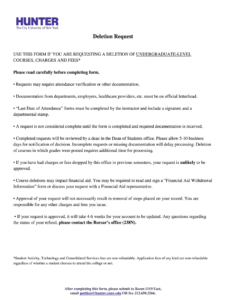Understanding the purpose and structure of these forms is crucial for navigating data privacy regulations and exercising control over online information. The following sections explore the specific components, legal basis, and practical implications involved in greater detail.
Key Components of a Data Removal Request Form
Effective data removal requests require specific information to be considered valid and actionable. The following components are typically essential:
1: Personal Identification: Accurate identification of the requestor is crucial. This may include full legal name, current address, and any previous names or addresses associated with the information sought for removal.
2: URLs to Be Removed: Specific URLs containing the information to be de-indexed must be provided. Generic requests or those lacking precise URLs are less likely to be successful.
3: Justification for Removal: A clear and concise explanation detailing the reasons for removal is necessary. This explanation should refer to relevant legal grounds, such as outdated information, inaccurate information, or irrelevant information impacting privacy rights.
4: Proof of Identity: Supporting documentation, such as a copy of a passport or driver’s license, may be required to verify the requestor’s identity and prevent fraudulent requests.
5: Contact Information: A valid email address and phone number allow for communication regarding the request status and any further information required.
6: Date and Signature: Including the date and signature (if applicable) affirms the request’s legitimacy and formality.
A complete and well-structured request increases the likelihood of a successful outcome. Providing accurate information, clear justification, and verifiable identification strengthens the request and facilitates efficient processing.
How to Create a Data Removal Request
Creating a comprehensive data removal request involves assembling key information and presenting it clearly and effectively. The following steps outline the process:
1: Gather Necessary Information: Compile all relevant personal information, including full legal name, current and previous addresses, and any other identifying information associated with the online content.
2: Identify URLs for Removal: Locate and list the specific URLs containing the information to be removed. Ensure accuracy and avoid generic requests. The more precise the URL list, the more effective the request becomes.
3: Establish Justification for Removal: Determine the legal grounds for the removal request. Clearly articulate why the information is outdated, irrelevant, inaccurate, or otherwise infringes upon privacy rights. Referencing relevant legislation strengthens the justification.
4: Prepare Proof of Identity: Gather necessary documentation to verify identity, such as a copy of a passport, driver’s license, or other official identification. This step ensures request legitimacy and prevents fraudulent submissions.
5: Draft a Formal Request: Compose a formal letter or email containing all the compiled information. Maintain a professional tone and present the information concisely and accurately. Include the compiled personal information, the list of URLs, the justification for removal, and contact details.
6: Attach Supporting Documentation: Include copies of the proof of identity and any other supporting documentation that strengthens the case for removal. Ensure all documents are legible and clearly labeled.
7: Submit the Request: Send the completed request to the appropriate data controller or search engine. Follow their specified submission process, whether through an online portal, email, or physical mail. Retain a copy of the submitted request for future reference.
8: Follow Up: After submitting the request, allow a reasonable timeframe for processing. If no response is received within the expected timeframe, follow up with the data controller to inquire about the request status.
Meticulous preparation and clear articulation of the request, supported by relevant documentation, contribute significantly to the effectiveness of a data removal request. A well-structured request promotes efficient processing and increases the likelihood of a positive outcome.
Standardized forms for requesting removal of personal information from online search results offer a crucial mechanism for individuals seeking to control their digital footprint. Understanding the components, purpose, and benefits of these structured requests is essential for navigating the complexities of online privacy and data control. Accurate completion of these forms, supported by clear justification and verifiable identification, significantly impacts the effectiveness of the process. This empowers individuals to assert their rights and facilitates efficient processing by data controllers and search engines, leading to more timely and satisfactory outcomes.
Effective management of online presence requires proactive engagement with available tools and resources. Leveraging standardized request processes contributes to a more balanced and equitable digital environment, fostering greater user agency and control over personal information. The continued development and utilization of these mechanisms remain crucial for navigating the evolving landscape of online privacy in the digital age.

